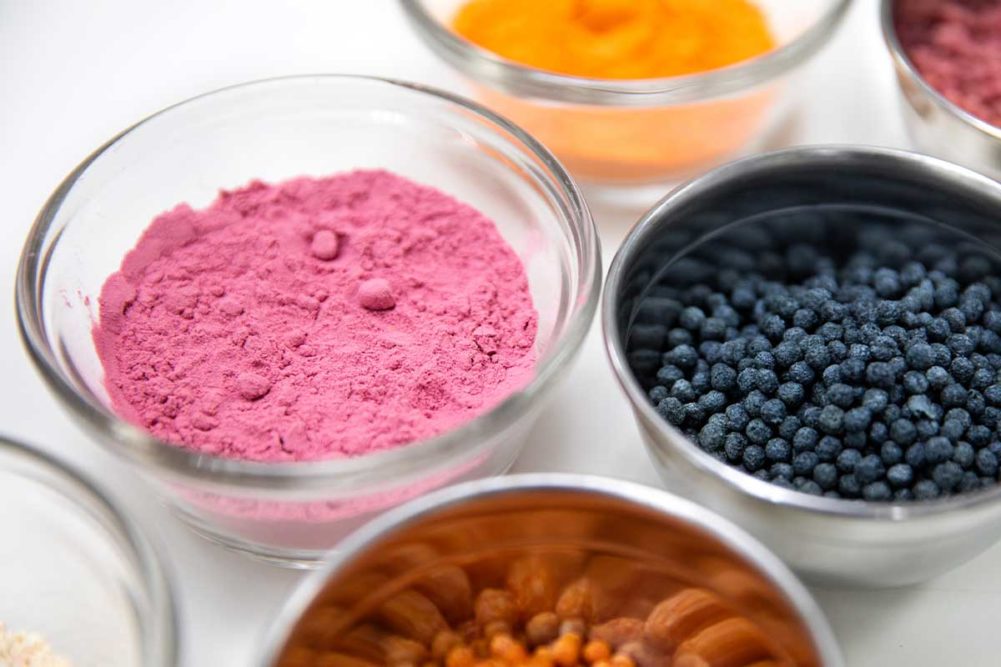Take a look around at some of the vivid hues of baked goods, and you will see a rainbow of possibilities: bright reds and blues, pinks and purples that pop and every other shade in between.
And as much as today’s foods stand out, the future is looking even more dazzling. This year is poised to be a one of freedom of expression, said Kelly Newsome, senior marketing manager, colors, ADM.
“Globally, 56% of consumers say they like food to have bright and intense colors,” Ms. Newsome said, citing an FMCG Gurus’ “Flavor, Color & Texture Trends” report. “Loud and bright shades of pink are bringing a new wave of fierce expression to over-the-top baked goods, desserts and snacks. Key examples of this are the Barbiecore trend and viva magenta, Pantone’s 2023 color of the year. Other colors that help shift consumer moods toward brighter and lighter moments are shades of blue, teal, purple and orange.”
Brilliant colors provide consumers with an emotional boost, said Alice Lee, technical marketing manager for GNT USA.
“Brightly colored baked goods and snacks present a huge opportunity space for brands that want to connect with consumers on an emotional and psychological level,” she said. “Consumers are hugely receptive to the use of vibrant shades because they’re craving products that have a story to tell and spark feelings of joy and creativity. As modern shoppers are increasingly prioritizing mindful, healthful consumption, though, it’s important to make those products with natural ingredients.”
Color is a key component in creating people’s expectation of how foods are going to taste, and adding colors can heighten expectations.
“We expect to see a bright red product to be cherry- or strawberry-flavored, dark blue for a blueberry product and vibrant yellow for a lemon product,” said Susan Frecker, senior application scientist, Oterra Inc. “The more intense the color, the more flavor we expect.”
Because baking can dull natural colors, additives can restore vibrancy.
“Color additives are often needed to replace color lost during exposure to light, air, extremes in temperature — baking — to correct natural variations in color of raw materials — such as fruit— and to add eye appeal and fun,” Ms. Frecker explained.
And as consumers embrace all-natural ingredient lists, the food industry is moving away from artificial colors.
“While artificial colors are still widely used in the United States, the majority of the newer brand product launches now tend to be formulated with natural colors,” Ms. Lee said. “We expect the demand for natural colors to grow exponentially in the years to come as consumers seek healthful products that are beneficial for their own well-being and the well-being of the planet.
Meghan Skidmore, marketing specialist, Sensient Food Colors, said that a variety of influences are making natural colors more commonplace in new product launches.
“Globally, the transition from synthetic or artificial ingredients to naturally sourced continues to move forward under encouragement from consumers and pressure from NGOs and increasing scrutiny from regulatory bodies,” she said. “Today, Mintel data show that 84% of bakery and snack products launched in the past three years with colors include natural colors globally. In North America, the percentage is slightly higher at 87%.”
Natural colors can be perceived as expensive and more limited in shade compared to synthetic alternatives, Ms. Skidmore said. Improving the cost of natural colors and extending the rainbow are both priority areas of innovation.
“It’s important to meet consumer demands for bright, bold colors while maintaining simple ingredient lists with natural solutions,” she said.
This article is an excerpt from the February 2023 issue of Baking & Snack. To read the entire feature on Colors & Flavors, click here.




